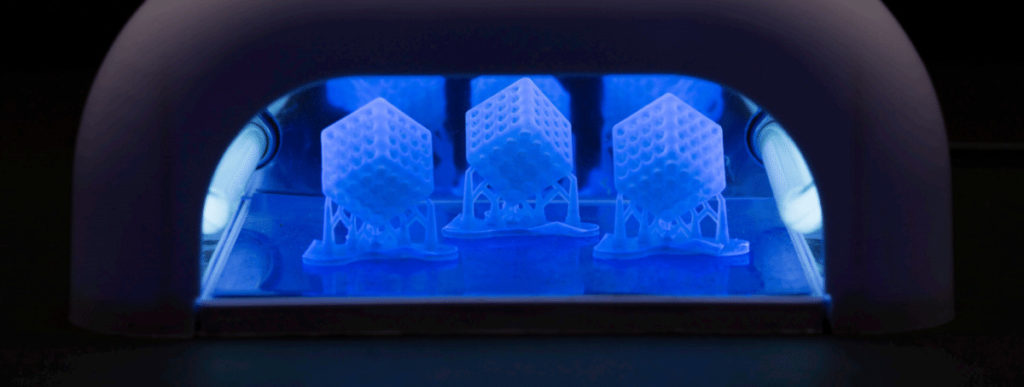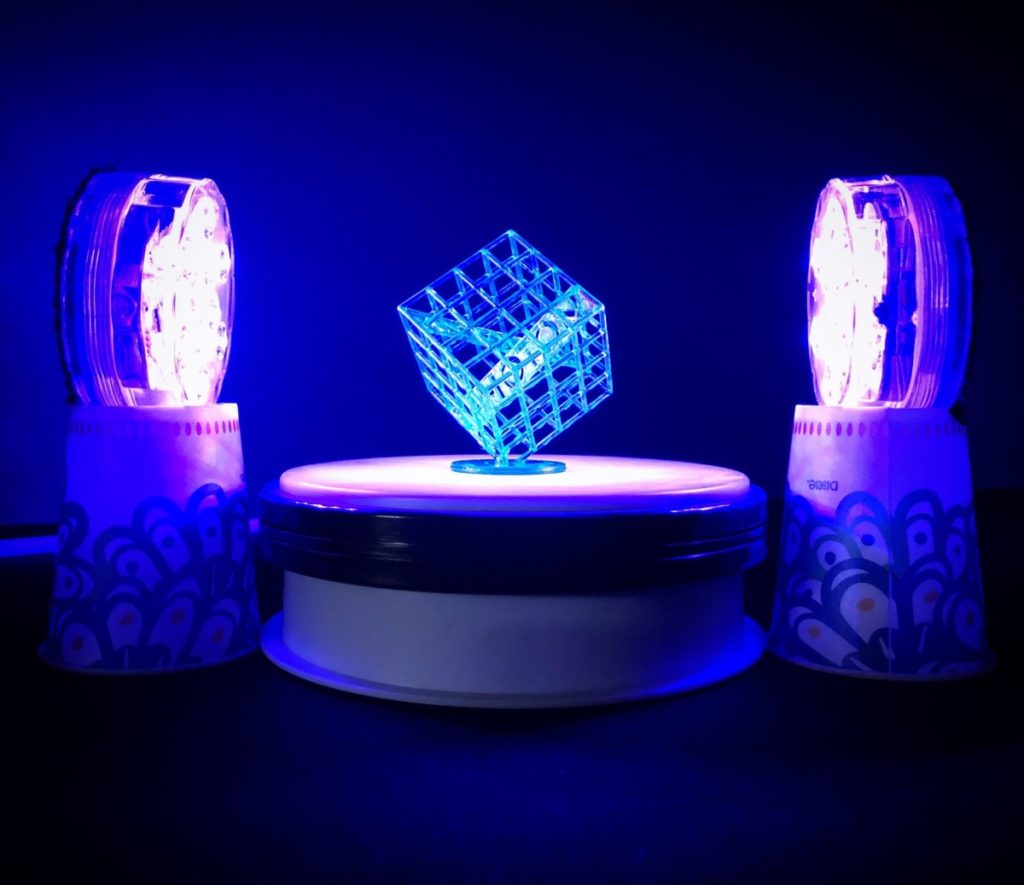Over curing resin prints is a controversial subject that is peppered with conflicting opinions. However, the general consensus supports the notion that resin prints can be over cured.
There is still much more research and testing required to fully grasp why some prints fail much sooner than others when over cured, but over curing is a real thing.
It is common knowledge that a combination of UV light and heat cure 3D resins and unless a UV protective layer is used then a resin print will continue curing when exposed to the sun’s UV rays.
Naturally, the intensity of the sun’s UV rays is far less than a conventional curing box. So, the curing process does continue in sunlight but is literally reduced to a snail’s pace.
Prints become brittle when over cured, and their impact resistance will weaken over time. The structural integrity of prints is definitely compromised when the curing process is pushed beyond normal or acceptable limits.
So, in short yes: Resin parts can be over cured if exposed to UV light for too long. The light coming from a UV curing chamber is much stronger than the effect that sunlight has on the resin prints, and leaving them overnight will already show some signs of degradation. Leaving them out in the sun will also make them become brittle, but this process will take more time.
The reach of natural UV light tends to be limited, but the degrading effect it has on the resin is clearly visible. Natural UV rays have a degrading impact on 3D resin prints as the curing process will continue until the chemical reaction is exhausted.
How to Cure Resin Prints

The initial curing of the resin takes place in the printer. Resin is selectively exposed to UV light and hardens to give shape to the print. A post-printing process is necessary to further harden and improve the structural integrity of resin prints.
A heated UV curing chamber is the most widely used method of post-curing as it shortens the time required to reach the final product.
Post curing is a combination of light, heat and time, depending on the resin type and the desired final result. The whole process can be achieved using sunlight, but this will increase the time required to complete the process.
Once the print is removed from the print plate, it is washed with isopropyl alcohol to remove the excess uncured resin. At this point, the print is not considered fully cured and will require additional UV exposure and heat to reach the desired result.
Let’s take a closer look at the different ways resin can be cured:
Cure Resin Prints with a UV Light

3D resin changes its physical characteristics when exposed to UV light. It will harden, and as long as it is exposed to UV light, the hardening process will continue. As stated, a UV curing station is most commonly used as it drastically reduces the curing- and production time. The combination of UV and heat has been tested and proved effective in enhancing resin print strength.
Different types of UV curing stations are available on the market where some are specifically designed for selected resin types. But many hobbyists build their own and experiment with a variety of resins for different print projects.
If you want to cure your prints in a controlled environment, you can check out this kit specifically made for our purpose at hand. It might sound odd, but lots of hobbyists also cure prints using a UV Lamp for Nails.
How long does it take to cure a 3D resin print under UV light?
Curing times vary, and this depends on the actual print and the intensity of the UV light. If it is a bulky or thick print, the curing time may be slightly longer as opposed to a small, less dense print.
The range is anywhere between a minute to an hour or a bit longer, but this is subject to conditions and desired results. Generally, the process takes anywhere from a minute to five minutes in a UV curing chamber.
Additionally, see through resins will take less since light has an easier time passing through them.
Cure them out in the sun

Sun curing as a post-production curing option is time-consuming and can take up to a few hours at the very least. You will have to either turn your print to get an even distribution of sunlight or use reflectors, so your print is evenly exposed.
Alternatively, sunlight curing can be combined with a water bath for a more even distribution of UV light, especially with the addition of reflectors.
There is always the chance of overcuring when using sunlight as UV intensity differs throughout the day. Depending on where you are geographically, heat, although a necessary part of the curing process must still be controlled.
Will curing resin prints underwater speed up the curing time?
According to Peopoly, using a water bath will speed up the curing time and water also helps with heat dissipation as well as diffusing the light, which will benefit the overall curing process since the reflections will help cure your model more evenly.
If you intend on using sunlight to complete the curing process, it is best to use a water bath as direct sunlight may cause it to crack. Oxygen slows the curing process to a degree and using a water bath somewhat solves that problem.
An additional consideration is that glass blocks some UV light and only the uncovered top of a glass bath will allow UV light into the bath. A print will have to be turned facing up to catch the UV light, which means turning of the print every so often is necessary.
Use Isopropyl alcohol
Isopropyl alcohol is a cleaning agent and not a curing agent. Once you printed your resin model, it’s time to wash it, and the washing process comes before the final curing part that usually takes place in an external UV curing chamber (all the previous steps I just mentioned).
Isopropyl alcohol is used to wash off uncured resin still on your print.
The benefit of washing off uncured resin is that it will not cure and distort your print, and by cleaning off the excess uncured resin, the post-curing time will be a little shorter.
Why are the 3D prints sticky even after curing?
The actual printing process does not fully cure the resin but allows a degree of softness that creates an adhesive surface for the next layer. At each pass, the UV light will pass through the layer currently being cured and will further cure the layer or layers behind it. Once the print is complete, it will require additional curing to harden it to the desired level.
No matter how good the resin is, there will always be parts that react slower to the curing effect and might not harden at all. This is another reason why you should shake bottled resin before use.
Sticky prints are caused by the uncured resin. Resin not affected during printing will remain on the print and needs to be washed off using isopropyl alcohol.
If the washing process is not done properly, the uncured resin will remain on the print. This usually happens with a contaminated washing solution brought on by overuse.
The post-curing process in the UV chamber may have to be increased slightly to ensure the print is properly cured, but ultimately the fault lies with improperly washed prints.
How to avoid sticky prints
To avoid sticky resin prints, the isopropyl alcohol washing process needs to be managed more effectively. The answer is not as simple as extending wash times since this may lead to another host of complications which you should avoid.
The ideal way of going about it is to have a two-step process where you wash/clean the print in two different containers; The first wash clears away most of the uncured resin and will lose its effectiveness much quicker than the second wash, and the second wash will tackle hard to reach areas of the print.
So, don’t just place your resin prints in one container filled with IPA, but after cleaning them in it place them into a second one and use fresh IPA to clean them further.
With more stubborn prints that even after doing all of this continue to be sticky, you can use a brush soaked in IPA to rinse off any excess uncured resin. Once you’re done with this wash the prints again in IPA like you did in the beginning.
Are Sticky resin prints toxic?
The resin in its uncured form is generally considered toxic. I say generally because there are non-toxic printing resins on the market. A sticky print indicates that there is uncured resin on the print’s surface, but the amount is really small and may not cause any severe health risks.
Nevertheless, it is best to wash the print thoroughly in isopropyl alcohol and have it cured properly. Any product marked as toxic should be treated with care no matter the amount of exposure to it.
Conclusion
Over Curing is definitely a possibility and you should try and avoid leaving your prints inside of a UV curing chamber for too long. If left for an entire night, for example, there will be some signs of degradation on the print and it will become more brittle.
Follow the steps I laid out in this article and you shouldn’t run into too many issues, just remember to handle resin with care since it’s very toxic. So, gloves and other protective gear must be used at all times.
I hope this information was useful, have a great day!
Check out our recommended products section

We created a recommended products section that will allow you to remove the guesswork and reduce the time spent researching what printer, filament, or upgrades to get, since we know that this can be a very daunting task and which generally leads to a lot of confusion.
We have selected just a handful of 3D printers that we consider to be good for beginners as well as intermediates, and even experts, making the decision easier, and the filaments, as well as the upgrades listed, were all tested by us and carefully selected, so you know that whichever one you choose will work as intended.
Error processing API data.
